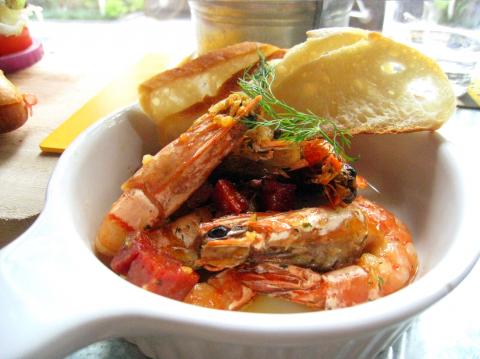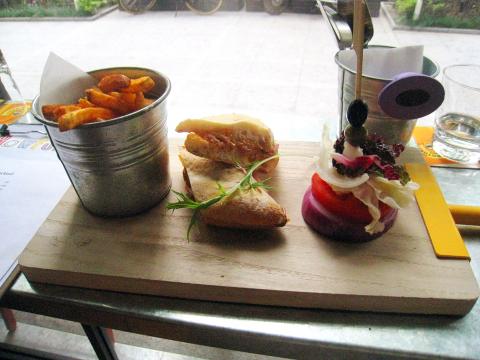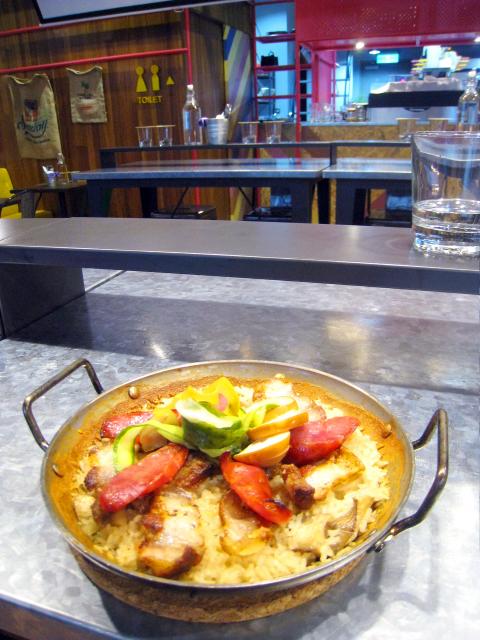The name of the HowFun Paella Bar (好飯食堂) in Chinese is a play on “good rice,” which seems fitting for an establishment purporting to prepare one of the world’s classic rice dishes, the Spanish paella — which in terms of culinary iconography is right up there with the Italian risotto and Indian biryani. It would therefore be nice if HowFun actually did serve good rice, but alas, this is not the case.
The recently opened fusion of sports bar, tapas bar, cafe, pub and chic eatery shows all the symptoms of advanced gastronomic schizophrenia so common among restaurants going for a fusion vibe. In appearance, HowFun is stylish in an invitingly casual way. It has minimalist bar seating, a clutter of copper and steel pots and pans hanging from the ceiling, a neat semi-open kitchen in back and, for those who like that sort of thing, a massive screen for sports coverage; all of which can be seen through the glass frontage.
The industrial chic of its table service, with its tin buckets, miniature cast iron paella dishes, and wood serving boards, further build up atmosphere and expectation. It is clear at a glance that great care has been taken with the design and styling of this establishment. It would be nice if the same could be said about the food.

Photo: Ian Bartholomew, Taipei Times
While there is no inherent contradiction between sports coverage and a tapas bar, the attempt to infuse classic Spanish food with Taiwanese characteristics enters dangerous waters. Noting the chef’s special Taiwanese flavor paella with sausage and pork (特製台灣風味好飯, NT$260 with tea, coffee or cola), I could not help myself. I dove in, hoping for the best, but prepared for the worst. My worst fears were realized, and not just as a result of the Taiwanese flavor. Paella is a dish in which the cooking of rice is of the utmost importance, but what appeared before me was a veritable stab of rice that was sticky and heavy and dry. The flavoring from grilled pork belly and Chinese sausage gave the rice a taste not dissimilar to that of a rice dumpling (粽子, zongzi), but one that was well passed its use-by date.
The belly pork was over-seasoned and a little tough. It added a greasy sheen to the dish that was remarkably unpleasant. The sausages were garden-variety Chinese sausages, and the sweetness they gave off further heightened my dislike of the dish. As with any innovative cooking, one can appreciate the effort and creativity without actually liking the result, but in the case of this paella, the whole thing seemed thrown together haphazard, like strangers at a bar after too much booze.
With the other paella dishes such as the deep fried sirloin steak paella with “pasto” (sic) sauce (NT$400, 羅勒沙朗牛排好飯) and the saffron seafood paella with prawns (NT$660, 澎湖大明蝦海鮮好飯), it was once again the flat, board-like appearance of the rice (as well as the price) that put me off.

Photo: Ian Bartholomew, Taipei Times
Along with the paella, I ordered the traditional Spanish fried calamari with tartar sauce (NT$99, 西班牙經典酥炸中卷佐塔塔醬), but the crumbed squid was more American diner than Spanish loncheria. It was adequate without being memorable. The garlic shrimp with chorizo (NT$120, 大蒜蝦) also failed to deliver a standout flavor, though the presentation was nice.
The final test was to launch myself at a classic jamon bocadillo with aioli sauce (NT$260, 經典帕瑪火腿西班牙三明治). A bocadillo is a Spanish sandwich, a symphony of crisp bread, rich meats and various pickles. It is indeed a Spanish classic and when well made has few rivals. The item that was presented to me looked quite attractive, but even before the first mouthful I was fully aware that this was not any kind of bocadillo that a Spaniard would recognize. The bread was nice enough, but the flavor of the jamon was smothered in a gloopy, vaguely garlicky sauce. It was served with a pyramid of salad, the base of which was a quarter inch thick round of raw onion that was impossible to eat. Considerations of flavor seemed to have been cast aside by the imperatives of design. Good chips though, but no cigar.
As for beverages, HowFun offers the usual selection of coffees, a range of organic teas, a selection of cocktails and regular and boutique beers. Service can be a bit snooty, but staff are on the whole pleasant and helpful, though a little remote for the kind of friendly, welcoming atmosphere HowFun seems to be aiming for.

Photo: Ian Bartholomew, Taipei Times

May 11 to May 18 The original Taichung Railway Station was long thought to have been completely razed. Opening on May 15, 1905, the one-story wooden structure soon outgrew its purpose and was replaced in 1917 by a grandiose, Western-style station. During construction on the third-generation station in 2017, workers discovered the service pit for the original station’s locomotive depot. A year later, a small wooden building on site was determined by historians to be the first stationmaster’s office, built around 1908. With these findings, the Taichung Railway Station Cultural Park now boasts that it has

The latest Formosa poll released at the end of last month shows confidence in President William Lai (賴清德) plunged 8.1 percent, while satisfaction with the Lai administration fared worse with a drop of 8.5 percent. Those lacking confidence in Lai jumped by 6 percent and dissatisfaction in his administration spiked up 6.7 percent. Confidence in Lai is still strong at 48.6 percent, compared to 43 percent lacking confidence — but this is his worst result overall since he took office. For the first time, dissatisfaction with his administration surpassed satisfaction, 47.3 to 47.1 percent. Though statistically a tie, for most

Wooden houses wedged between concrete, crumbling brick facades with roofs gaping to the sky, and tiled art deco buildings down narrow alleyways: Taichung Central District’s (中區) aging architecture reveals both the allure and reality of the old downtown. From Indigenous settlement to capital under Qing Dynasty rule through to Japanese colonization, Taichung’s Central District holds a long and layered history. The bygone beauty of its streets once earned it the nickname “Little Kyoto.” Since the late eighties, however, the shifting of economic and government centers westward signaled a gradual decline in the area’s evolving fortunes. With the regeneration of the once

In February of this year the Taipei Times reported on the visit of Lienchiang County Commissioner Wang Chung-ming (王忠銘) of the Chinese Nationalist Party (KMT) and a delegation to a lantern festival in Fuzhou’s Mawei District in Fujian Province. “Today, Mawei and Matsu jointly marked the lantern festival,” Wang was quoted as saying, adding that both sides “being of one people,” is a cause for joy. Wang was passing around a common claim of officials of the People’s Republic of China (PRC) and the PRC’s allies and supporters in Taiwan — KMT and the Taiwan People’s Party — and elsewhere: Taiwan and